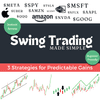
📊 Unlock Powerful Stock Charts!
Get real-time data, custom indicators, and in-depth stock analysis with TradingView.
Try TradingView FreeWhy I’m Betting Big on Snowflake (SNOW): A Growth Investor’s Take
Mon, Dec 23, 2024
Table of Contents
- Why I’m Investing in Snowflake (SNOW) in 2024
- Is Snowflake Still Growing in 2024?
- How Is Snowflake Positioned in the Market?
- Is Snowflake Overvalued?
- Why Am I Investing Despite the Risks?
- What Are the Risks of Investing in Snowflake?
- How Does Snowflake Compare to Industry Trends?
- What I’ll Be Watching Moving Forward
- Is SNOW a Good Stock to Buy Now?
- What Will Snowflake Stock Be Worth in 2030?
- Who Owns the Most SNOW Stock?
- Final Thoughts
Why I’m Investing in Snowflake (SNOW) in 2024
Snowflake Inc. (SNOW) has been on my radar for a while. As someone who’s okay with calculated risks, especially in growth stocks, I’ve decided it’s time to open a position. Sure, there are challenges—high valuation, tough competition—but when I look at the growth story and future potential, I think it’s worth the risk. Here’s my take on why I’m investing and what I’ll be keeping an eye on.
Is Snowflake Still Growing in 2024?
Absolutely, and at a pace that’s hard to ignore. Snowflake’s revenue has shot up from $1.2 billion in FY 2022 to nearly $2.8 billion in FY 2024. That’s a compound annual growth rate (CAGR) of 52%. Most top-tier tech companies grow around 20-30% annually, so Snowflake is far exceeding that benchmark.
What really caught my attention is their customer retention. Their net revenue retention rate is 127%, which means customers are not only sticking around but also spending more over time. That’s a clear sign they’re delivering serious value. For context on how retention drives valuation, you can check my GitLab stock analysis.
How Is Snowflake Positioned in the Market?
Snowflake competes in the cloud data platform space with heavyweights like Databricks, AWS, and Google Cloud. Despite the competition, they’ve carved out a strong position. Their ability to operate across multiple cloud platforms (AWS, Azure, Google Cloud) makes them a flexible choice for enterprises that don’t want to be locked into one ecosystem.
Another smart move? Their usage-based pricing model. Customers pay based on how much they use, which aligns perfectly with fluctuating business needs. And let’s not forget their big push into AI. Snowflake’s partnership with Anthropic positions them to tap into the growing demand for AI-driven analytics. They’re not just keeping up—they’re staying ahead.
This approach reminds me of the strategy behind companies like Block (SQ), which I wrote about in my Block stock analysis. Both companies are leveraging innovative pricing models to drive adoption.
Is Snowflake Overvalued?
Here’s the thing: Snowflake isn’t cheap. Their valuation metrics are sky-high:
- Price-to-Earnings (P/E): 181.82
- Price-to-Sales (P/S): 16.33
- Price-to-Book (P/B): 18.89
For comparison, most tech stocks in this space have a P/E closer to 30x. So yeah, you’re paying a premium. But I think it’s a calculated gamble. Snowflake’s growth trajectory and innovative edge justify the price, at least for me. If you want a broader perspective on high valuations, you might enjoy my take on Robinhood’s valuation.
Why Am I Investing Despite the Risks?
There’s no sugarcoating it—Snowflake comes with risks. The valuation is steep, the competition is fierce, and they’re not consistently profitable yet. But here’s why I’m still in:
First, their revenue growth is off the charts. Few companies can sustain the kind of growth Snowflake has shown. Second, their focus on AI and multi-cloud flexibility sets them apart in a crowded market. And finally, their retention rate speaks volumes about the quality of their platform. For me, the potential rewards outweigh the risks.
What Are the Risks of Investing in Snowflake?
Every investment has its downsides, and Snowflake is no exception. Here’s what I’m keeping in mind:
- Valuation Concerns: At these levels, a lot of future growth is already priced in. Any hiccup could lead to a sharp drop.
- Profitability Timeline: While they’re improving, they’re not consistently profitable yet. Continued investments might delay this.
- Tough Competition: Databricks, AWS, and Google Cloud aren’t slowing down. Snowflake will need to keep innovating to stay ahead.
For a deeper dive into managing risks in growth stocks, you might find my analysis of Hims & Hers Health (HIMS) insightful.
How Does Snowflake Compare to Industry Trends?
The cloud data platform market is booming. It’s expected to grow at a compound annual growth rate (CAGR) of 15% over the next 3-5 years, with Snowflake’s total addressable market projected to hit $290 billion by 2027. This isn’t just a temporary trend—it’s a long-term growth story. Snowflake is well-positioned to ride this wave.
What I’ll Be Watching Moving Forward
Now that I’ve opened a position, I’ll be keeping a close eye on a few key things:
- Profitability Trends: Are they getting closer to consistent profits?
- Competitive Edge: How are they differentiating themselves from Databricks and other rivals?
- Sector Growth: Is the cloud and AI space still growing as expected?
- Valuation Alignment: Does their valuation continue to make sense as they report new earnings?
Is SNOW a Good Stock to Buy Now?
If you’re a growth investor comfortable with some risk, Snowflake is worth considering. Analysts are largely bullish, with 27 out of 38 rating it as a “Buy.” The average price target is around $183.86, which suggests some upside from current levels.
What Will Snowflake Stock Be Worth in 2030?
It’s tough to predict exact numbers, but with a total addressable market of $290 billion and their strong growth trajectory, I believe Snowflake could continue to deliver significant gains over the next decade. If they execute well, especially in AI and multi-cloud solutions, they could be a major player by 2030.
Who Owns the Most SNOW Stock?
As of now, institutional investors hold the majority of Snowflake’s stock. Top stakeholders include firms like Vanguard, BlackRock, and Morgan Stanley. Insider ownership is relatively low, but that’s typical for a company at this stage.
Final Thoughts
Investing in Snowflake is a bet on growth, innovation, and the future of data. It’s not a stock for the faint of heart, but for someone like me, who’s okay with calculated risks, it’s a compelling opportunity. Their revenue growth, strategic moves in AI, and strong market position make them a standout in the cloud space.
If you’re thinking about investing, make sure it fits your risk tolerance and long-term goals. For me, Snowflake is worth the bet, and I’m excited to see how they evolve in the coming years.
Original Tweet 👉
Not financial advice, just sharing my thoughts!
Related Posts
Free Cash Flow Margin (FCF Margin) - Revenue Lies. Profit Misleads. This Tells the Truth.
Tue, Jun 10, 2025
Learn how free cash flow margin reveals a company’s real cash health beyond profit and why it matters for smarter investing decisions.
Free Cash Flow - This One Number Reveals What a Company Really Makes
Fri, Jun 6, 2025
Learn what free cash flow really means, how to calculate it, and why it matters more than revenue in stock analysis.
Gross Margin - This One Metric Can Make or Break a Business — Here's Why
Thu, Jun 5, 2025
Learn how gross margin works, why it matters to investors, and what it reveals about a company’s pricing power and cost structure.
🌟 Buy Me Coffee
Love the market insights, stock analyses, and investing tips I share? Help me do more by buying me coffee. Your support funds deeper research, keeps content ad-free, and helps create more tools and resources for the community.


